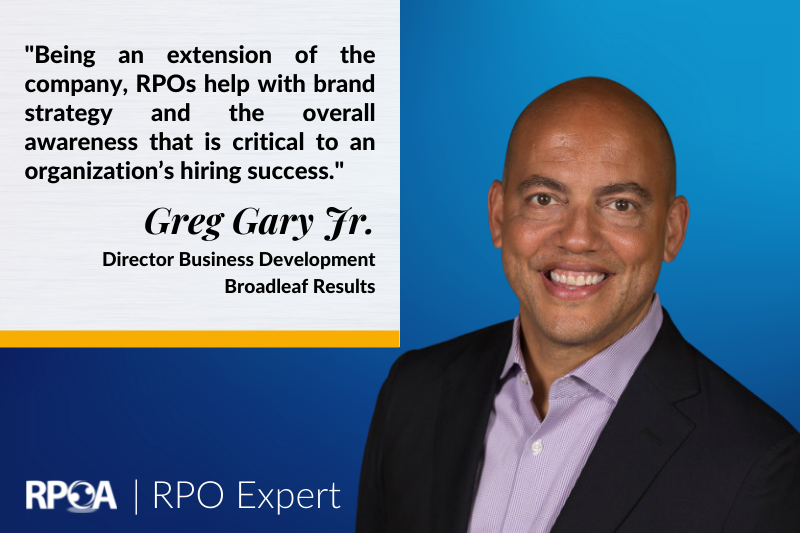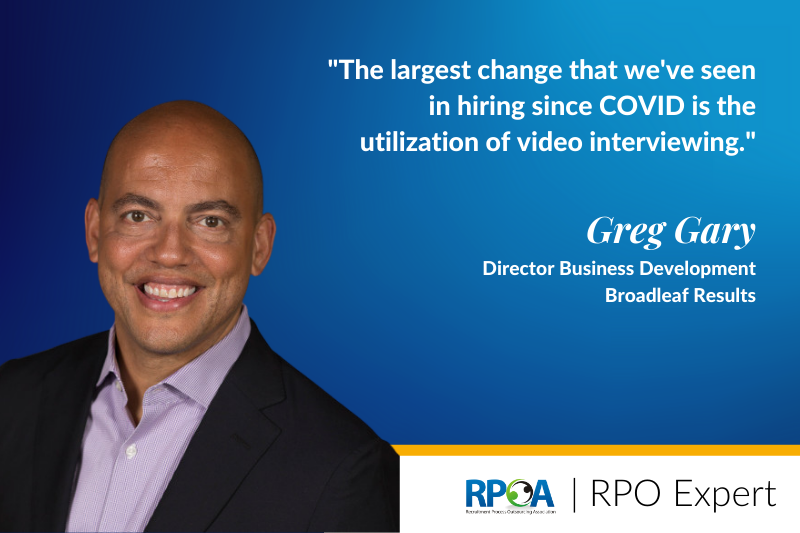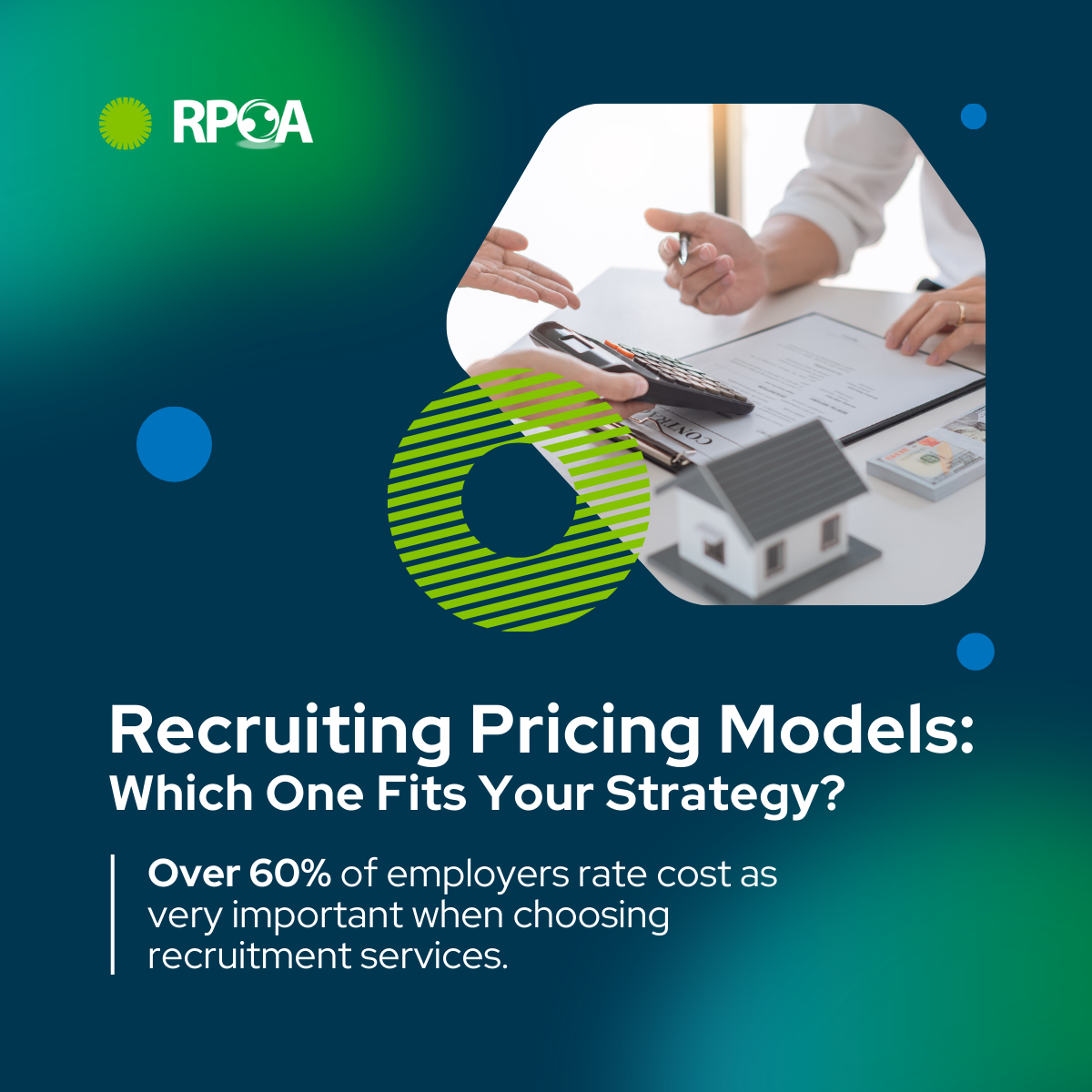
Greg Gary is Senior Director of Business Development for Broadleaf Results, an Aleron company delivering value-driven, customer-focused managed service programs, RPO, SOW management, payrolling, and independent contractor compliance. In his role, Greg is responsible for working with clients to build total talent management solutions that provide greater workforce visibility and insights, enhance compliance and risk mitigation, improve efficiency, and drive measurable and sustainable results.
As a member of the RPO Expert Series, Gary shared his insights with RPOA’s Executive Director, Lamees Abourahma, on what talent leaders should know about recruitment process outsourcing (RPO). The following is the first of a 3-part edited version of that conversation.
RPOA: Some RPO buyers have experience with RPO. Some don't have any experience. What should they know before working with an RPO?
Gary: The level of experience with an RPO doesn't matter. Regardless of experience level, it always starts with the same question. What talent problems are you trying to solve? It’s important to first, understand your hiring challenges, whatever they may be. And then from there, come up with what you’d like to see in a successful outcome.
The next part is to make sure you know what type of positions or what scope of work you would like to have in the program.
How can TA leaders know whether RPO is the right solution for them?
It starts with that same question of what are you really solving for? Are you solving for bandwidth, expertise, turnover, or location? Or is it a spike in growth, a spike in hiring needs? Again, It starts with understanding what it is you're trying to accomplish.
From there, you’ll need to look into other things, such as whether you’re facing a critical mass of hires at a particular location or job title. Or are you dealing with a critical mass of ongoing or project-based hiring needs? If so, RPO is the right fit for you.
And it's also important to know if it's 8 to 10 positions or less, utilizing a search agency may be a better solution. Then once it becomes a larger project with a need for more positions, then it's likely more of an RPO.
How does the duration of the project affect a potential RPO buyer's decision?
There are all types of projects. Some last two to three months, others last a year, two years, or are evergreen. But even with the smaller projects, there's still a business case for RPO.
So really, it's more of a question of, is there a business case for the project versus the time length of the project? We've done many projects that are three to six months, large projects that require mammoth hires, and 300-plus worker hiring that needs to be done in three months. Some others may have that same hiring volume, but stretch over12 months to complete.
The only time where the length of the project becomes an issue or challenge is if it's a mass number that will be difficult to reach. That's when we can see an issue with a shorter project, but outside of that, length of time is just another factor in an overall program.
What are some tips to start a successful RPO program?
You're going to hear me say the same thing over and over—before you start an RPO program, it’s important that you define a successful outcome and really understand what talent problems you’re trying to solve.
And then you need strong executive sponsorship. It’s critical that executive leadership be active participants, especially in the beginning. Anybody who's been in any type of a program or project of any sort, you know that from time to time, there are going to be obstacles and challenges. Change management is always something we talk about—it’s a challenge for many people. Having that executive sponsorship will help you overcome those challenges.
Another part is a willingness to be self-aware. Where does your organization really sit? Self-awareness is critical because many times you hear a lot of people who think their organization is the greatest. It's like any of us who are parents—we think our child is the greatest, most intelligent child ever, and you're going to have a hard time proving to me otherwise. However, the teacher might tell you something different, right?
It's the same thing with your organization. It's critical to be aware of where you stand? Do you have an issue with your hiring process today? Is there something that's slowing you down within? What is that? Let's talk about it. And then let's utilize data to reinforce whatever that thought was, or maybe to make us realize that thought was incorrect. But whatever it is, it's important to make sure you can look introspectively and really understand where the challenges are that your organization is facing.
You also need to understand the factors that influence an RPO project. For one, compensation—if there are five other competitors in your area and they are paying $5 more than you are, well, that's something of which you really need to be self-aware and understand how that's going to impact you. Right now we're going through the Great Resignation, which is making quite an impact, so understanding what those factors are is critical. The pandemic has moved many people to remote work. In the old days, everybody was coming into the office from nine to five but that's not the case anymore. So making sure that you understand those types of factors, those outside factors that impact your business, that's going to be a critical piece.
What are some RPO buyers’ misalignments or unrealistic expectations of RPO?
There's the obvious one that everybody tends to realize—it's more expensive than you think. Everybody wants the hiring cost to be 5 percent of the cost per hire or 5 percent of the annual salary. Although we'd love for that to happen for you, too, however, in this day and age, that's probably not realistic. You know you're looking at more than 8 to 12 percent of a cost per hire for most opportunities, especially in the professional world.
Another big misalignment or area that I think is important to understand is knowing what the implementation looks like, what the go-live looks like, and what success looks like—that's critical. It typically takes, depending on the organization, somewhere between four to seven weeks to actually implement your program. During that time, you should not expect to see much success because we're just beginning your program, or if there is some level of success, it's going to be minimal because we're not recruiting yet. During those first four to six weeks of the implementation, there may be some things we're doing in the background, but there's really not any recruiting happening during that time.
Then we have our go-live date. Oftentimes a company believes that ‘okay, we went live today, which means I should start seeing interviews by tomorrow.’ But that's not realistic. Realistically, you're going to see true success come about 30 days after go-live because it does take time to recruit, to get the interview setup, to get the interviews flowing and going, especially for that first couple of go-rounds.
So we always want to make sure all of our clients know, it's a four-to-six-week implementation. And then after that, when we go live, we're going to start to see the success really happening 30 days later. It's critical that both sides understand the process and agree on it upfront because that saves a lot of heartburn during the process.
There may also be some misalignment in the pricing models—another area that is very critical. As you're looking at providers, make sure you have a provider that has various options from a pricing perspective. Oftentimes, RPO buyers believe there's only one type of model. And that creates worry such as ‘I don't know if that model fits here. I don't know if that model is going to fit our culture and what we need to do. I don't know if that model fits our budget the way we have it set up.’
One of the ways I'd like to see [RPO buyers] thinking is, ‘here's what our budget is, here's what we're trying to do. Do you have a model that fits what we're trying to do?’ Because odds are we do. Your better RPO providers are going to have three, four, possibly even five different pricing models that will allow you to best align one that works for you. This ensures that you can align that proper model for your work anticipation.
Another part where the alignment may be off or can be off is in the disbursement of the jobs. Sometimes people want to just give you 500 today, and bang, let's make it happen. And why don't you have all 500 of those ready to go within 30 days? Or there may be phased approaches in various ways. So one of the things that you typically want from your RPO provider is to sit down, look at the number of opportunities there are, and look at what we expect the funnel to look like. And then be realistic in how you can expect to see the numbers change.
Suggested webinar on-demand: How Recruitment Process Outsourcing Can Help Businesses Address the Great Rehire














